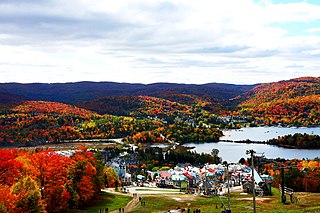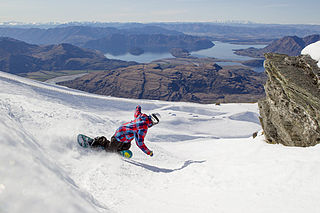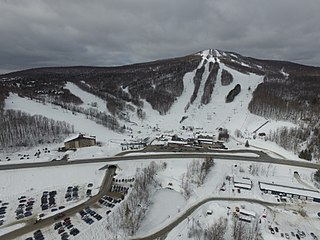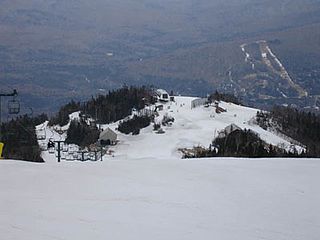
A ski resort is a resort developed for skiing, snowboarding, and other winter sports. In Europe, most ski resorts are towns or villages in or adjacent to a ski area – a mountainous area with pistes and a ski lift system. In North America, it is more common for ski areas to exist well away from towns, so ski resorts usually are destination resorts, often purpose-built and self-contained, where skiing is the main activity.

Mammoth Mountain Ski Area is a large ski resort in the western United States, located in eastern California along the east side of the Sierra Nevada mountain range in the Inyo National Forest.

Mont Tremblant Ski Resort is a year-round resort in the Laurentian Mountains of Quebec, Canada, located about 130 km (80 mi) northwest of Montreal. It is best known as a ski destination, but also features Lake Tremblant suitable for swimming and two golf courses in the summer months. The name of the mountain, Mont Tremblant, was derived from the Algonquin indigenous people, who called it the "trembling mountain." The summit is at an elevation of 875 m (2,871 ft), which makes it one of the tallest peaks in the Laurentians. One km north of the principal down hill area is the Edge, an area of glade skiing and 2.8 km (1.7 mi) north of that is the true summit, Pic Johanssen, which has a trail over the top and is Black Diamond for skiers and boarders. The resort is owned by Alterra Mountain Company.

Treble Cone is the closest ski area to Wānaka, New Zealand.
Jay Peak Resort is an American ski resort located on Jay Peak in the Green Mountains, between the Village of Jay and Montgomery Center, Vermont. Its vertical drop of 2,153 feet (656 m) is the eighth largest in New England and the fifth largest in Vermont. Although mostly located in the town of Jay, Vermont, part of the resort, including the summit of Jay Peak, the Jet Triple Chair area and much of the Big Jay backcountry descent, is located in the town of Westfield, Vermont. The resort is just 4 miles (6.5 km) south of the Canada–United States border, above which is the Province of Quebec.

Alta is a ski area in the western United States, located in the town of Alta in the Wasatch Mountains of Utah, in Salt Lake County. With a skiable area of 2,614 acres (10.58 km2), Alta's base elevation is 8,530 ft (2,600 m) and rises to 11,068 ft (3,374 m) for a vertical gain of 2,538 ft (774 m). One of the oldest ski resorts in the country, it opened its first lift in early 1939. Alta is known for receiving more snow than most Utah resorts, with an average annual snowfall of 545 inches (13.8 m). Alta is one of three remaining ski resorts in the U.S. that prohibits snowboarders, along with nearby competitor Deer Valley and Vermont's Mad River Glen.

Killington Mountain Resort & Ski Area is a ski resort in Rutland County, Vermont, United States, near the town of Killington. It is the largest ski area in the eastern U.S., and has the largest vertical drop in New England at 3,050 feet. Since the 2013–14 ski season, it has been called the "Beast of the East."

Big White Ski Resort, simply known as Big White, is a ski resort located 56 km (35 mi) southeast of Kelowna in the Southern Interior of British Columbia. It is located on Big White Mountain, the highest summit in the Okanagan Highland, an upland area between the Monashee Mountains and the Okanagan Valley. Big White is the third largest resort in British Columbia, after Whistler-Blackcomb and Sun Peaks. In 2019, Big White was nominated as the third-best ski resort in Canada by Snowpak.

Beaver Creek is an unincorporated community in Eagle County, Colorado, United States. Beaver Creek is located immediately south of the town of Avon and encompasses the Beaver Creek Resort and adjacent business, lodging, golf course, and residential areas. The U.S. Post Office at Avon serves Beaver Creek postal addresses.

Sugarbush Resort is a ski resort located in the Mad River valley in Warren, Vermont, owned by Alterra Mountain Company. It is one of the largest ski resorts in New England. The resort encompasses more than 4000 acres (16 km²) total, 484 trail acres (2.34 km²) skiable, 53 miles (85 km) of trails, and 16 ski lifts. Sugarbush has 111 ski trails, 18 additional marked wooded area, substantial off-piste skiing and riding, a summit elevation of 4,083 ft (1,244 m), and a vertical drop of 2,600 feet (790 m), second largest in Vermont after Killington, and the third largest in New England after Killington and Sugarloaf.

Mount Hood Meadows is a ski resort on the southeastern face of Mount Hood in northern Oregon, and is the largest of the mountain's ski resorts. It is located about 67 miles (108 km) east of Portland, and 35 miles (56 km) from Hood River along Oregon Route 35. It has both Alpine and Nordic ski areas and offers night skiing, lessons and equipment rentals. There are no overnight accommodations at Mount Hood Meadows itself, but a number of hotels and motels nearby offer shuttle services to the resort. There are also condos in Government Camp.

Bromley Mountain is located in southern Vermont, United States and is part of the Green Mountains. It is located in the town of Peru, Bennington County, seven miles (11 km) east of Manchester, Vermont and just west of the Peru town center. It is a popular destination for skiing and snowboarding.

Park City Mountain Resort (PCMR) is a ski resort in the western United States in Park City, Utah, located 32 miles (51 km) east of Salt Lake City. Park City, as the ski resort and area is known, contains several training courses for the U.S. Ski Team, including slalom and giant slalom runs. During the 2002 Winter Olympics, it hosted the snowboarding events and the men's and women's alpine giant slalom events.

Blue Mountain Resort is a ski resort located in Palmerton, Pennsylvania on Blue Mountain.

Waterville Valley is a ski resort in Waterville Valley, New Hampshire, United States. It is located within the White Mountain National Forest. Built on Mount Tecumseh, with a summit elevation of 3,997 feet (1,218 m) above sea level, the ski trails extend to a high point on the south ridge of the mountain at 3,840 feet (1,170 m), offering a vertical drop of 2,020 feet (615 m). The ski area has 11 lifts, including two high-speed quads and the slopes primarily face east and northeast.
Catamount Ski Area is a ski resort located on Mount Fray of the Taconic Mountains in Hillsdale, New York and South Egremont, Massachusetts. Catamount is one of three ski areas in the southern Berkshires; the others are Butternut in Great Barrington, and Otis Ridge in Otis. It is one of the few remaining family-owned ski areas in New England. In addition, Catamount is home to one of the largest youth ski race programs in the Northeast.

Dodge Ridge Wintersports Area is a ski area near Pinecrest, California in Tuolumne County, off of Highway 108, 30 mi (48 km) east of Sonora. The resort is located in the Stanislaus National Forest and operates under a special use permit. Many skiers in Northern California use Dodge Ridge because of its proximity to the San Francisco Bay Area, San Joaquin Valley and Yosemite National Park. The winter sports season typically lasts from late November through mid April. The mountain summit sits at 8,200' above sea level. Dodge Ridge was founded by various individuals, and managed by the Purdy family, in 1950, and then owned by the Helm family from 1976 up until the 2021-2022 season, when it was acquired by Invision Capital and Karl Kapusciniski. Dodge Ridge is a member of Powder Alliance, which offers reciprocal ski passes to season pass holders of various resorts. Beginning in the 2021/2022 season Dodge Ridge began to experiment with "light snowmaking at the base."
Powdr Corporation, stylized as POWDR, is an American privately held company that owns and operates ski resorts in the United States and Canada. It is headquartered in Park City, Utah, and was founded in 1994 by John Cumming, co-founder of the clothing company Mountain Hardwear.
















